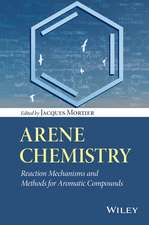Acyclic, Carbocyclic and L-Nucleosides
Autor L. Agrofoglio, S.R. Challanden Limba Engleză Paperback – 7 sep 2012
The success of the early nucleoside agents, the toxicity and metabolic instability of many nucleoside analogues, and the effects of viral pathogens on public health are driving the design, synthesis and evaluation of new nucleoside analogues, with much attention turning to nucleosides containing `non natural' sugar analogues. This book focuses on the development of these agents, and draws together all the available material in an easily consulted form, which at the same time guides the reader into the research literature on the subject. Written primarily for the medicinal chemist, coverage includes both synthetic strategies and outline guidance on the main trends in biological activity. Particular attention is drawn to the comparison of synthetic routes to compounds with their natural analogues. Finally, the important antiviral activities of the compounds are treated, including anti-retrovirus, anti-hepadnavirus and anti-herpes virus properties.
Written mainly for medicinal chemists in the pharmaceutical industry and synthetic organic chemists in academe, this book will also be attractive to researchers in institutions focusing on cellular metabolism. Advanced students of organic chemistry will find the clear discussion of the synthetic strategies adopted in the development of these compounds a useful introduction to this exciting and challenging area.
| Toate formatele și edițiile | Preț | Express |
|---|---|---|
| Paperback (1) | 1221.51 lei 6-8 săpt. | |
| SPRINGER NETHERLANDS – 7 sep 2012 | 1221.51 lei 6-8 săpt. | |
| Hardback (1) | 1227.67 lei 6-8 săpt. | |
| SPRINGER NETHERLANDS – 31 oct 1998 | 1227.67 lei 6-8 săpt. |
Preț: 1221.51 lei
Preț vechi: 1489.65 lei
-18% Nou
Puncte Express: 1832
Preț estimativ în valută:
233.77€ • 243.15$ • 192.99£
233.77€ • 243.15$ • 192.99£
Carte tipărită la comandă
Livrare economică 14-28 aprilie
Preluare comenzi: 021 569.72.76
Specificații
ISBN-13: 9789401037341
ISBN-10: 9401037345
Pagini: 396
Ilustrații: X, 383 p.
Dimensiuni: 155 x 235 x 21 mm
Greutate: 0.55 kg
Ediția:Softcover reprint of the original 1st ed. 1998
Editura: SPRINGER NETHERLANDS
Colecția Springer
Locul publicării:Dordrecht, Netherlands
ISBN-10: 9401037345
Pagini: 396
Ilustrații: X, 383 p.
Dimensiuni: 155 x 235 x 21 mm
Greutate: 0.55 kg
Ediția:Softcover reprint of the original 1st ed. 1998
Editura: SPRINGER NETHERLANDS
Colecția Springer
Locul publicării:Dordrecht, Netherlands
Public țintă
ResearchCuprins
General introduction.- References.- 1 The chemistry of acyclic nucleosides.- 1.1 Introduction.- 1.2 Acyclovir and its derivatives.- 1.3 Ganciclovir (DHPG) and its derivatives.- 1.4 Acyclic nucleoside phosphonate analogues.- 1.5 Seconucleosides and their derivatives.- 1.6 Miscellaneous acyclic nucleosides.- References.- 2 Biological activity of acyclic nucleosides.- 2.1 Introduction.- 2.2 Acyclovir and its prodrugs.- 2.3 Ganciclovir and its prodrugs.- 2.4 Penciclovir and famciclovir.- 2.5 Phosphonylmethoxyalkylpurines.- 2.6 HEPT.- 2.7 Allenes.- 2.8 Conclusion.- References.- 3 The chemistry of carbocyclic nucleosides.- 3.1 Introduction.- 3.2 Coupling procedures for introducing the heterocycle moiety.- 3.3 Synthesis of functionalized cyclopentylamines with ribo-, arabino-, or xylo-configurations.- 3.4 Fluorinated carbocyclic nucleoside analogues.- 3.5 Carbocycles substituted by other functional groups.- 3.6 Cyclobutyl analogues of nucleosides.- 3.7 Synthesis of cyclopropyl analogues of nucleosides.- 3.8 Cyclohexyl nucleosides.- References.- 4 Biological activity of carbocyclic nucleosides.- 4.1 Introduction.- 4.2 Inhibitors of AdoHcy hydrolase (SAH).- 4.3 Inhibitors of viral DNA replication.- 4.4 Reverse transcriptase inhibitors; carbovir and its prodrugs.- 4.5 Cyclopropyl- or cyclohexyl- analogues of nucleosides.- 4.6 Conclusion.- References.- 5 The chemistry of L-nucleosides.- 5.1 Introduction.- 5.2 Synthesis of L-nucleosides.- 5.3 Synthesis of iso-L-nucleosides.- 5.4 Summary.- References.- 6 Anti-viral activities of L-nucleosides.- 6.1 Introduction.- 6.2 Anti-viral activity of ?-L-ddNs.- 6.3 Activities of ?-L-oxothiolanyl and dioxolanyl nucleosides.- 6.4 Activity of ?-L-fluorinated nucleosides.- 6.5 Activity of miscellaneous ?-L-nucleosides.- 6.6 Conclusion.-References.- Appendix A Nomenclature of nucleosides.- Appendix B Abbreviations in widespread use.- Appendix C Glossary of terms used.- Appendix D Acknowledgements.





